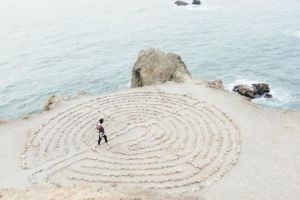Integrating Well-Being in Your Classroom: Easy and Quick Activities
“The mind is everything. What you think, you become.” – Gautama Buddha
Warning: You are not being asked to do one more thing on top of your overflowing plates. What follows are resources for you to use at your own choosing and pace.
We recognize that instructional faculty and our students are living in a time when massive change and stress are at an all-time high. And in a recent Chronicle of Higher Education post, Aisha Ahmad provides a perspective on acceptance and reimagining ourselves during these times of uncertainty – an important reminder of doing what we need now to take care of ourselves for the short and long term.
The Center for the Advancement of Well-Being and the Office of Faculty Affairs & Development collaborated to create a list of short well-being activities instructional faculty can use in the classroom. You don’t need to be an expert on the science and application of well-being to support your students. There’s a growing body of research that provides evidence for many of these activities. Here are a few examples:
Mindfulness for Teachers: A Pilot Study to Assess Effects on Stress, Burnout and Teaching Efficacy
Mindfulness Practice Leads to Increases in Regional Brain Gray Matter Density
The following quick and simple activities can help you and your students get focused and centered. We call these “re-wiring activities” – rewiring your brain to optimize learning and engagement. Some instructors facilitate these activities at the beginning of each class session. After coming back from a break would be another good time to incorporate one of these activities. They can be as short as a quick one-word check-in that might take 5-7 minutes depending on class size. You can control the amount to time for each of these.
In our experience, students appreciate the time devoted to de-stressing and being able to get into the present moment. You can mix up and repeat any of these well-being practices. The key is to find the ones that work for you and your students. If you are holding online synchronous classes, you can use the chat feature, call on your students by name, or ask them to use the raise hand feature in your virtual classroom to offer their contributions and reflections.
COLLECTION OF BRIEF RE-WIRING PRACTICES
Breathing Exercises These short, simple exercises will bring focus and calm to you and your students.
These short, simple exercises will bring focus and calm to you and your students.
Acceptance Mantra with Breath
Take low and slow deep breaths while repeating the mantra. Change the words if they don’t work. Practice for 2-5 minutes.
- On the inhale: Breathing in, I do my best.”
- On the exhale: “Breathing out, I will let go of the rest.”
Box Breathing
Try this deliberate breathing pattern for a few minutes at a time.
- Slow inhale for 4 seconds
- Hold breath gently for 4 seconds
- Exhale slowly for 4 seconds
- Hold breath gently for 4 seconds
- Repeat for 2-3 minutes
Building a Sense of Self-Compassion
Directions: Close your eyes for a few seconds and take a deep breath.
Ask yourself what is present in your life right now. What is claiming your attention? It may be a concern regarding your finances, family… Whatever it is, just allow it to surface.
As whatever you are present to surfaces, mentally say:
May I find the strength and resources to navigate what is here now.
May I find acceptance for everything that is coming up for me [Accept that whatever reaction I am having to what is happening around me, it’s okay. It’s real!] May I find good and positive ways to work with these reactions
May I remember that I am not alone despite our physical distancing.
Take a deep breath and bring your attention back to the room.
To Extend Kindness to Others in the Class
Directions: Close your eyes for a few seconds and take a deep breath.
Think of someone else in this class that might benefit from some positive energy and encouragement. Silently, take a moment to identify that person and note for yourself why that person comes to mind. What’s your relationship to that person? Why do you want to send them your positive energy? For the duration of the class, keep that person in mind. And continue to do so even beyond the class into the rest of your day. Take a deep breath and bring your attention back to the room.
 These activities are used to bring our focus into the present moment.
These activities are used to bring our focus into the present moment.
Minute to Arrive
Use to bring more complete presence to the classroom. before starting class, when most are settled in, ask students to pause and take a quiet moment to fully arrive. This practice can also be used when coming back from breaks or to start meetings.
Sensing Things in the Moment Activity
Ask students to identify the things listed in the moment after each of the 5 prompts below. This is all about observing and being in the moment of the here and the now. The things you can feel can provide a great piece to return to later when you need to re-ground and re-center.
Prompts with Examples
5 things I can see from where I am right now: my camera, a sleeping dog, a glass of water, hand lotion, a box of Kleenex
4 things I can hear from where I am right now: the TV downstairs, a dog barking outside, birds chirping, a plane coming into land
3 things I can feel (physically) from where I am right now: flannel sheets, the leaves of the rabbit’s foot fern, my soft shirt, my wrists
2 things I can smell from where I am right now: lavender lotion that just went on my hands, a scented candle burning
1 thing I can taste: the Trader Joe’s chocolate meringues that I just ate (and might be addicted to!)
Three Breaths (Close Eyes)
- Focus on Breath
- Focus on relaxing body
- Ask yourself what’s important now (to focus on the present moment)
 A 2009 study of college students suggested that regular journaling improves mood and well-being. Give 2-10 minutes to journaling or reflective writing. You can also ask students to share responses if time allows.
A 2009 study of college students suggested that regular journaling improves mood and well-being. Give 2-10 minutes to journaling or reflective writing. You can also ask students to share responses if time allows.
Select a prompt or generate your own relevant prompts:
- Write about your biggest accomplishment over the last week?
- Reflect on things you are grateful for at this moment.
- Name 5 people who have inspired you recently, and explain why.
- Talk about an obstacle you overcame today.
- Give an example of when you helped someone else achieve one of their goals.
- Discuss a big decision that frightened you initially, but paid off in the end.
- What would you like to learn more about? How will you go about doing this?
- Describe the last time you felt the emotion of awe.
Daily Quarantine Questions
One or more of these questions can be used as reflective writing prompts.
What am I grateful for today?
Who am I checking in on or connecting with today?
What expectations of “normal” am I letting go of today?
How am I getting outside today?
How am I moving my body today?
What beauty am I either creating, cultivating, or inviting in today?
Two Good Things (or One Good Thing depending on the size of your classroom)
Ask students to take a moment to think about two good things in their lives at the present moment. You can ask them to write them down. Then ask them to share with the rest of the class.
Self-Care Reflection
To encourage self-care, ask people to simply identify one thing they will do for themselves before the end of the day to help them keep going. You can ask people to write that thing down to help remind them, as it might help to increase accountability. You can also ask everyone to share the one thing they will do, as it might provide inspiration to others. You can change this up as needed – one thing before the end of the day, one thing tomorrow before you start working, one thing before your day ends, etc.
 These practices, similar to the breathing and centering exercises, will increase mindfulness, paying attention in the present moment, on purpose, and without judgment. These qualities can help with stress management, concentration, and emotional regulation, including improved ability to deal with negative feedback and challenging circumstances.
These practices, similar to the breathing and centering exercises, will increase mindfulness, paying attention in the present moment, on purpose, and without judgment. These qualities can help with stress management, concentration, and emotional regulation, including improved ability to deal with negative feedback and challenging circumstances.
Head, Body, Heart Check-In
Use to bring a more mindful quality to responses when facing adversity.
- Head – What are the thoughts here?
- Body – What sensations do I notice? What emotions and intuitions do I sense and how is that informing me?
- Heart – What values are at play here? What is my intention?
Meditation Recordings
Play these short meditations for your class:
Simply Pausing (2:30 minutes)
Focusing (3:20 minutes)
Focusing/Centering (3:29 minutes)
Mental Stillness (5 minutes)
Body Scan (2:44 minutes)
Loving-Kindness Meditation
The loving-kindness meditation is tied with self-compassion, empathy, understanding, and kindness. Ask students to be in a sitting position with feet on the floor and close their eyes if they’re comfortable doing so. Ask that everyone not speak and for the room to be completely silent. Provide a few moments of silence for them to get centered before reading the following loving-kindness meditations. Read the following slowly:
For self:
- May I be strong.
- May I have the power to accept and forgive.
- May I live and die in peace.
- May I be safe.
- May I love and appreciate others boundlessly.
For others:
- May you be safe.
- May you live long.
- May you achieve what you want and deserve in life.
- May you have the power to accept your anger and sadness.
- May you be healthy and happy always.
Alternate Language for Loving-Kindness Meditation
- May you have the strength to overcome all your struggles.
- May you always be honest and truthful.
- May you get all the happiness you deserve in life.
- May you always be surrounded with people who love you and care for you.
Brief Body Scan (3 minutes)
Read this body scan script at the start of your class:
Begin by bringing your attention into your body.
You can close your eyes if that’s comfortable for you.
You can notice your body seated wherever you’re seated, feeling the weight of your body on the chair or the floor.
Take a few deep breaths.
And as you take a deep breath, bring in more oxygen enlivening the body. And as you exhale, have a sense of relaxing more deeply.
You can notice your feet on the floor, notice the sensations of your feet touching the floor. The weight and pressure, vibration, heat.
You can notice your legs against the chair, pressure, pulsing, heaviness, lightness.
Notice your back against the chair.
Bring your attention into your stomach area. If your stomach is tense or tight, let it soften. Take a breath.
Notice your hands. Are your hands tense or tight. See if you can allow them to soften.
Notice your arms. Feel any sensation in your arms. Let your shoulders be soft.
Notice your neck and throat. Let them be soft. Relax.
Soften your jaw. Let your face and facial muscles be soft.
Then notice your whole-body present. Take one more breath.
Be aware of your whole body as best you can. Take a breath. And then when you’re ready, you can open your eyes.
 Reading a piece of poetry or song lyrics at the beginning of class as a form of meditation and reflection can be a powerful way for students to clear their minds of stressful and negative thoughts. Below are examples of poetry that have themes of finding meaning and purpose in life and our connection to one another through nature and the natural world. Select poems/songs that resonate for you or ask your students to contribute.
Reading a piece of poetry or song lyrics at the beginning of class as a form of meditation and reflection can be a powerful way for students to clear their minds of stressful and negative thoughts. Below are examples of poetry that have themes of finding meaning and purpose in life and our connection to one another through nature and the natural world. Select poems/songs that resonate for you or ask your students to contribute.
Wild Geese by Mary Oliver
You do not have to be good.
You do not have to walk on your knees
for a hundred miles through the desert repenting.
You only have to let the soft animal of your body
love what it loves.
Tell me about despair, yours, and I will tell you mine.
Meanwhile the world goes on.
Meanwhile the sun and the clear pebbles of the rain
are moving across the landscapes,
over the prairies and the deep trees,
the mountains and the rivers.
Meanwhile the wild geese, high in the clean blue air,
are heading home again.
Whoever you are, no matter how lonely,
the world offers itself to your imagination,
calls to you like the wild geese, harsh and exciting –
over and over announcing your place
in the family of things.
Stars by Meg Wheatley
In places where air still offers clarity,
stars sing a siren song from space in the bright night.
Lying on soft earth,
carried into sky by longing,
humans respond to stars with questions. Why is the Universe so vast? Why are we so small?
Call and response through the night.
My whole life I have sent these questions into space. And listened for response.
Then sky wakens and star song fades.
Humans forget mystery and get on with living.
But the stars, the stars keep calling. No response.
Why is it that we call to stars with science and insignificance?
On the next ring night, find the clear air and ask again.
Humans, ask again. Who are we?
What is our place in mystery?
Perhaps you will hear what I have heard, a song of inner radiance.
For the stars
the stars are calling
saying we must
turn to one another
turn to one another and see
finally see
the stars everywhere.
I Bend by Selena Odom
I bend but do not break.
I’ve been lost, but I’m not a loser.
I’m a wreck, but I’m not totaled.
I’m fractured but not broken.
I’ve failed, but I’m not a failure.
I’ve fallen hard but can get up again.
I’m isolated, but still I’m free.
I have been destroyed but will rebuild.
My heart is broken, but it will mend.
See, no matter how close I come to breaking, I just continue to bend.
Inner Strength by John Read
It’s only through mistakes we make
We learn where we went wrong.
It’s only when we’re far from home
We realize where we belong.
It’s only when we close our eyes
Our dreams seem clear and bright.
It’s only in our darkest hours
We truly see the light.
It’s only when we lose our way
We pray to the stars above.
It’s only through times of grief
We learn the true meaning of love.
It’s only when all hope seems lost
And our weary journey seems so far,
When all the world’s against you,
We learn how strong we really are.
All things are sent to try us.
We must strive and give our best.
I believe God is watching over us,
And he guides us in our quest.
 Showing short video clips at the start of your class can help to shift the mood to one that will be more productive for your lessons. Positive emotions will aid in producing creativity, connection, and decrease stress and anxiety. Test the sound prior to class time and cue up the video so that you won’t incur ads when you are ready to share your screen.
Showing short video clips at the start of your class can help to shift the mood to one that will be more productive for your lessons. Positive emotions will aid in producing creativity, connection, and decrease stress and anxiety. Test the sound prior to class time and cue up the video so that you won’t incur ads when you are ready to share your screen.

